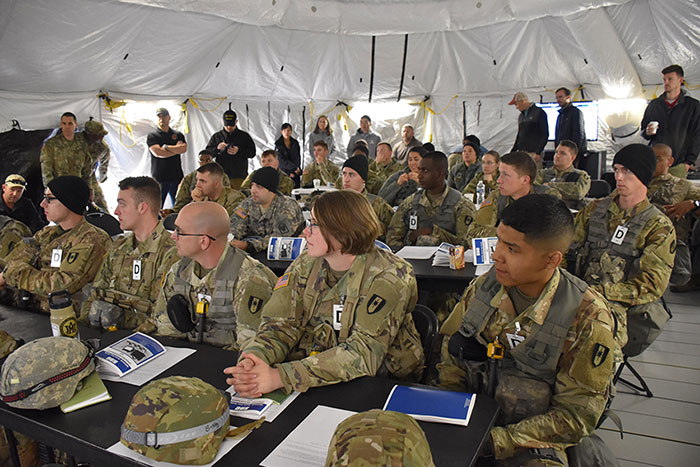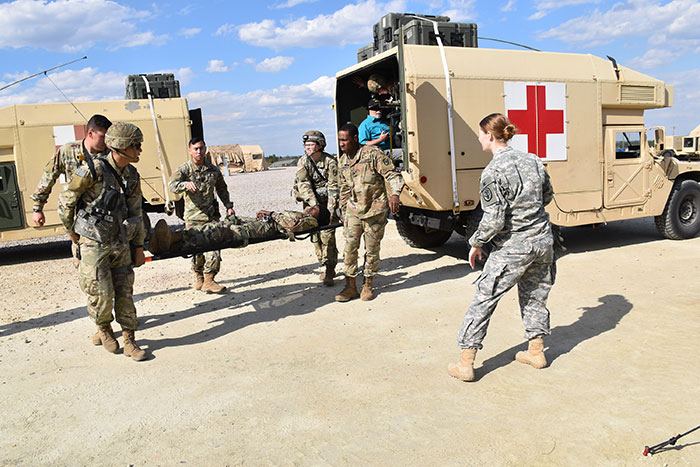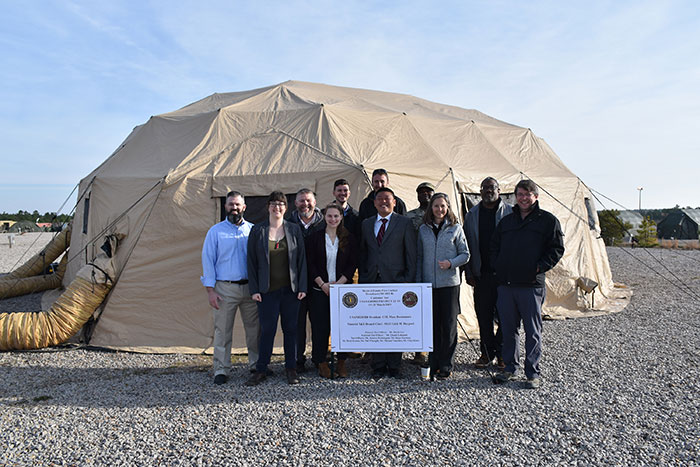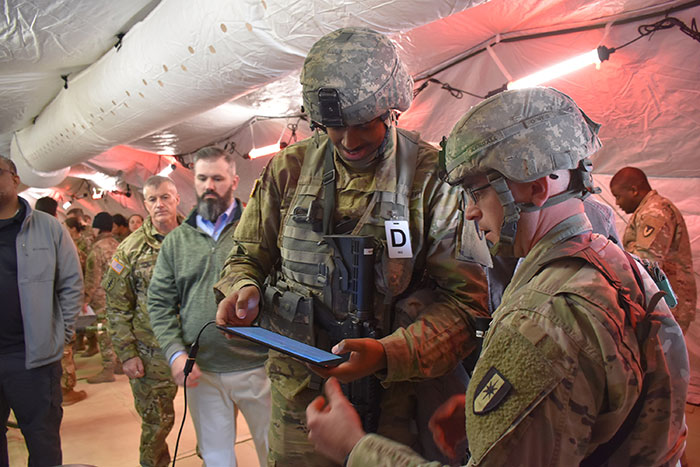Army Medical Communication System Reaches Milestone Test before Fielding to Soldiers

Two years ago, a lifesaving medical communication device was only an idea exchanged off-hours on a napkin. Now, the Medical Hands-free Unified Broadcast, or MEDHUB, system has completed its latest round of user testing to assess functionality in an operational-relevant environment. The Transport Telemedicine Systems program, which was originally initiated in 2013, was focused on bidirectional communications, also known as telementoring. In January 2017, an After Action Review was conducted with the Aero-Medical Evacuation user community. The results: due to the noise and vibrations, telementoring would be difficult in an operational environment. In addition, review of the battlefield communication platforms showed there was not sufficient bandwidth for telementoring.
Following this AAR, Jay Wang, product manager for the U.S. Army Medical Materiel Development Activity's Warfighter Health, Performance and Evacuation Project Management Office, established the MEDHUB concept. The MEDHUB system provides situational awareness of evacuation patients to improve readiness of deployed hospitals and reduces medic burden, while leveraging the minute Department of Defense tactical bandwidth available. Together with the help of his team of engineers, acquisition professionals and industry partners, the program underwent a new acquisition strategy, which allowed rapid prototyping that accelerated the schedule. Having completed independent operational assessment at Fort Bragg, North Carolina, with the 44th Medical Brigade in a Field Training Exercise, MEDHUB has reached Technology Readiness Level 8 within 24 months, and is one step closer to saving lives.
"Studies have shown, there's poor verbal and written communication when handing patients off between medical providers in a life and death situation. Not because they're bad at documenting or communicating, it's because their priority is performing lifesaving interventions," said Wang.

In a standard Army ambulance, one medic may treat up to six patients. MEDHUB uses U.S. Food and Drug Administration-approved medical devices integrated with an Android tablet and the existing DoD tactical satellite network to transmit patient information to the receiving hospital. MEDHUB relays that information as soon as patients are on the medical evacuation vehicle, increasing communication and providing enhanced situational awareness by allowing the deployed hospitals to see near-real-time patient status.
Without MEDHUB, deployed hospitals typically receive patient information from the MEDEVAC vehicle in the form of a radio call five minutes before the patients arrive. Conversely, when utilizing MEDHUB, medics complete a Tactical Combat Casualty Care card faster and with two times the accuracy compared to pen and paper.
Before deploying MEDHUB in the hands of Soldiers, MEDHUB must be tested for suitability and effectiveness in an operationally relevant environment. During the independent operational assessment, MEDHUB was evaluated during patient transport in ground and air ambulances, from the point-of-injury to the deployed hospital.
The 44th Medical Brigade provided test participants, some playing the role as medic, others as injured Soldiers, and it also provided ground ambulances and two hospitals. The Iowa National Guard provided two Blackhawk air ambulances and flight crews. A total of 10 scenarios were completed with over 40 Soldiers.
The only communication the MEDHUB team had with test participants was during the initial new device training session, which only lasted four hours. This ensured the best possible product would be fielded, because the Soldiers are responsible for operating MEDHUB without assistance from the product manager or trainers.

Pictured from left to right:
Front: Alexandra Cholewczynski (USAMMDA), Emily Krohn (USAMMDA), Jay Wang (USAMMDA), Jan Cooke (SNC), Mike Moore (AMRDEC)
Back: Cory Anderson (AMRDEC), Duston Thompson (SNC), JT McNeil (USAMMDA), Spencer Brooks (USAMMDA), Captain Gerrod Gomez (USAMMDA), and Torrence Moore (USAMMDA)
"The Soldiers either make it or break it on their own. The scenarios are as realistic as possible because our engineers will not be there with the Soldier if MEDHUB breaks out in the field," said Wang. "Through realistic simulations, we can identify the best parts of the system and the worst parts, and fix it before it gets to the field."
The U.S. Army Medical Department Test Board from San Antonio independently evaluated the system during independent operational assessment. Its role was to gather data while objectively monitoring everything from how the medics used the tablets, to the performance of the vital sign monitors and the transmission of MEDHUB data to the receiving hospitals.
"During data collection, we were not focused on the patient care or user skill level; instead, we documented their execution of what they were trained on regarding the system under test. Our goal was to collect as much data and get as much Soldier feedback as we possibly could so that we have a strong report," said David Lee, AMEDD's primary test officer from the Test Board.
The Medical Evacuation Proponency Division, which is the requirements office, observed the MEDHUB test. As a capability developer, this group ensures MEDHUB meets the Army's need for an automated solution for improved deployed hospital's patient situational awareness and improved patient documentation.
"I think MEDHUB is a technology worth a hard look. It has proven that a medical device can communicate with other medical devices, and it can utilize a military network to transmit information. Those are key pieces," said George Hildebrandt, retired flight medic and MEPD analyst.
On the second test day, key leaders observed MEDHUB in action and were truly impressed with the product's capabilities.
"This collaborative effort is critical to making these tests successful. It's really important to get that real user feedback during user testing because we really just want to make sure the system works for the Warfighter," said Army Col. Ryan Bailey, former USAMMDA commander.

"Data collected from the MEDHUB testing will ultimately determine its future fielding and use on the modern battlefield," said Army Col. Kimberlee Aiello, 44th Medical Brigade commander. "The technology it delivers has proven to be beneficial in its function to provide critical patient information in a timely and accurate manner."
Over the last two years, the MEDHUB team has reduced the logistical burden and maximized the fielded capabilities. One improvement is the ability to rapidly replace sensors. If a sensor breaks, a new sensor can easily be paired to the tablet — as easily as pairing your cell phone to your home speaker, thus increasing the operational availability of MEDHUB.
In addition, the MEDHUB team has continued to add medical capabilities to the system, such as the MEDHUB's Drug Rack, or DOSE, which stands for Drug Optimal Safety Equipment. DOSE existed as a prototype since 2018 and was tested for the first time during MEDHUB's testing in an operational environment. The medic, through use of the tablet, will select the medication, and DOSE will illuminate the corresponding drug to reduce medication errors. The device controls the access to drugs and tracks the use of narcotics, thus increasing the safety of the patient and provider. This product ensures the right drug, dosage and amount is provided to the right patient, preventing life-threatening medication errors.
Developing the MEDHUB program this far has required monumental efforts from the U.S. Army Medical Research and Development Command; USAMMDA; the U.S. Army Medical Materiel Agency; U.S. Army Combat Capabilities Development Command - Aviation and Missile Center; Program Executive Office Soldier; PEO Aviation; PEO Command, Control, Communications – Tactical; and Sierra Nevada Corporation.
"We are so fortunate to have gotten to where we are over the last two years. I cannot wait to field MEDHUB and help save our Warfighters' lives," said Wang.
The Operational Evaluation Report from this test will be used to influence final product design decisions and system fixes to be implemented. It will also be used to request the Milestone Decision Authority for permission to procure and deploy MEDHUB. Reaching Milestone C would mean the system will be ready for Low Rate Initial Production and an Initial Operational Test & Evaluation, which is the next step for MEDHUB. A small step taken now leads to a giant leap in lifesaving capability for the Warfighter.













